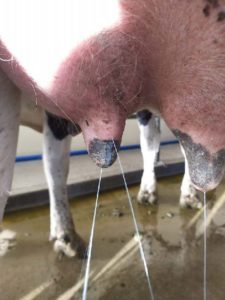Words by: Lisa Whitfield
This month has been a testing time for us on the farm at Massey No 1 Dairy. I have been privileged to be working on the farm as a primary relief staff member over the course of the year and have benefited greatly from the experience of being at the coalface of a farm.
Here we are used to operating at a cell count of about 100,000 or fewer. A clinical case will usually cause the cell count to go up by 10,00 to 20,000. In that situation we strip the herd and are usually able to find the culprit. However, since just after Christmas we have experienced spikes of up to 200,000. Despite a redoubled effort in preventative mastitis management and a lot of head-scratching, to have the cell count sitting between 130,000 and 160,000 for two weeks has been stressful and has caused a lot of thought about what has been going on. We had 10 cases of clinical mastitis in 10 days from a herd of 262.
The financial cost to the farm has been substantial, with treatments, dumped milk, and an additional staff member required at milking to allow for stripping the herd. We had the pulsators checked (all working well) and then a dynamic machine test was performed that identified some overmilking and a slightly high vacuum. Blood samples were assessed to double-check trace element status – which came back as normal. We could not grasp what had changed to cause the outbreak, and what the source of infection was.
Every other day we stripped the herd, only to find a new clinical case at the next milking. Staffing hadn’t changed, teat spray application was good, and the cows were going into good quality pasture, with no crops or feed pad use.
Every case gets cultured onfarm. There were three different bacteria at play – mostly Strep uberis cases, but also two Staph aureus cases, and one acute E. coli case. Cases were mostly in the left quarters, particularly the back left.
During two different milkings we noticed milk clots on the floor of the parlour, however we could never find where they came from, nor why they were in the middle of the parlour floor.
One lucky day, we discovered what we think was going on: one cow, in her second lactation, who had a small, additional mammary gland on the back of her udder, and a short, fused teat exiting partway down the back left teat. The additional gland had acquired mastitis and had periodically been discharging infected milk when the cups were on. Most likely she had been infecting other cows with the thick, sticky secretions, as well as adding a lot of cells to the silo. We breathed a big sigh of relief to have found out what was likely to have been going on.
The cow was made into a 3-titter immediately, as the position of the extra teat canal made a permanent cure not very feasible.
The cell count dropped by 50,000 the next day. She had a pure culture of Strep uberis from the gland. Did you know that Strep uberis can be spread from cow to cow in the right circumstances?
I feel that this story illustrates well the effect that a single cow can have on the bulk tank somatic cell count. A single cow, with an unchecked infection, caused an outbreak that pushed the cell count to double our normal level.

With the problem controlled, the cell count has headed back to a level where we are comfortable.
In the second half of the season, there is plenty to think about with regards to udder infections. Sources of infection tend to become more common – cattle grazing summer crops, plenty of dust, abundant flies, faecal contamination of dry paddocks, and cow-to-cow spread as the number of days in lactation increase.
It is more important than ever at this time of the year to continue to focus on excellent teat spray application, maintaining teat health, minimising overmilking as production wanes, and minimising faecal contamination of teats.
Planning your drying off strategy should be on the agenda now. Plan early to be prepared regardless of when the season draws to a close for your herd. Herd tests from now on can be used to identify cows that may need dry cow therapy – use data from within the last 90 days of lactation. Treat cows as individuals. Adding in the use of the rapid mastitis test well before their production drops, and targeted milk cultures, is useful to identify high cell count cows that will benefit from dry cow therapy versus those that will not.
Think about the effect a single cow can have on your cell count – if you are strategic in how you choose cows to dry off, you can have a large impact on mastitis with a relatively small number of cows. Antibiotic dry cow therapy does not fix mastitis problems – proactive management, planning, time, and effort does.
- Lisa Whitfield is a Manawatu-based production animal veterinarian.





